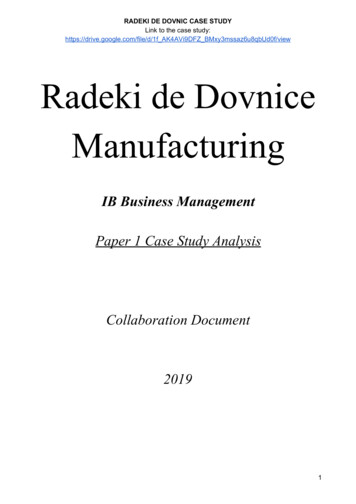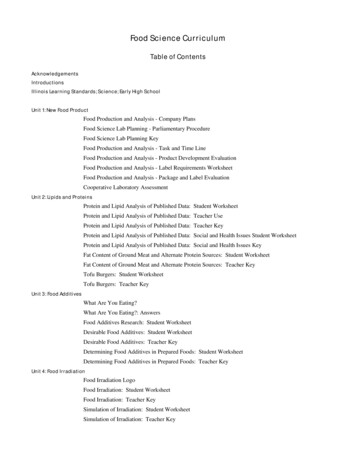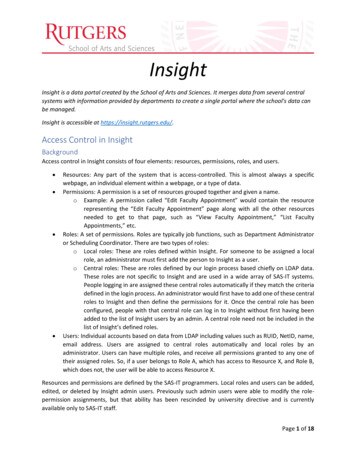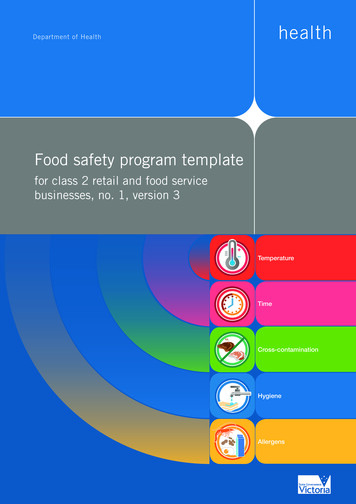
Transcription
Table of ContentsBackgroundMethodologyExecutive SummaryDemographicsDetailed Findings3457112
BACKGROUNDThe International Food Information Council (IFIC)Foundation’s 2018 Food and Health Survey marks the13th time the IFIC Foundation has surveyed Americanconsumers to understand their perceptions, beliefsand behaviors around food and food purchasingdecisions.This year, the survey continues an examination ofissues related to health and diet, food components,food production, and food safety. It also explores newtopics, such as food insecurity, diets and eatingpatterns, and how consumers’ diets compare todietary guidelines and expert recommendations.A supplement to this report, focused on Medicaidrecipients and in partnership with the Root CauseCoalition, will be released in October, 2018.3
METHODOLOGY Online survey of 1,009 Americans ages 18 to 80.March 12 to March 26, 2018. The survey tookapproximately 21 minutes to complete. The results were weighted to ensure that theyare reflective of the American population ages18 to 80, as seen in the 2017 Current PopulationSurvey. Specifically, they were weighted by age,education, gender, race/ethnicity and region. The survey was conducted by Greenwald &Associates, using ResearchNow’s consumerpanel. Note: changes in trend vs. 2017 are indicatedwhere appropriate with up and down arrows.4
Executive SummaryThis year’s 2018 Food and Health Survey seeks to understandconsumers’ perceptions and behaviors around food and foodpurchasing decisions. The findings from this year’s online survey of 1,009 Americansages 18 to 80 focuses on: The link between food and desired health outcomes How consumer diets compare to recommendations The prevalence and motivation behind certain eatingpatterns Information sources and trust Food and beverage purchase drivers The influence of food values and views on food safety Food insecurity and barriers to healthy eating In-person vs. online shopping Findings are presented for all respondents. Additional insightsare provided based on how findings vary by different types ofdemographic groups such as age, race, gender and income.Key FindingsThis year, some of the more compelling findings of the Food andHealth Survey include: Consumer confusion remains entrenched: Last year, the studyfound consumer confusion to be a prevalent issue. That finding isconfirmed again in 2018, with 80% who come across conflictinginformation about food and nutrition and 59% of those who saythat conflicting information makes them doubt their choices.This significant consumer segment also experiences heightenedstress while shopping. Context can influence the consumer’s judgment ofhealthfulness, even when the nutritional facts are the same:Despite being given two products to consider with identicalNutrition Facts Panels, consumers are swayed by the presence ofGMOs, a longer ingredients list, sustainable production,freshness and a sweeter taste.Key Findings Continued5
Executive SummaryKey Findings Continued Familiarity is a core purchase driver: While taste and price stillreign supreme as influential factors, familiarity (a new addition tothe 2018 survey) actually comes in a close third. The impact offamiliarity of product even outweighs healthfulness. Importance of sustainability on the rise: 6 in 10 consumers sayit is important to them that the food they purchase or consume isproduced in a sustainable way, an increase from 50% who saidthe same in 2017. In particular, reducing pesticide use andensuring an affordable food supply appear to be the issuesdriving this increased interest in the topic. Preference for no artificial ingredients and willing to pay for it:Despite the importance of familiarity, 7 in 10 consumers wouldbe willing to give up a familiar favorite product for one that didnot contain artificial ingredients. Of those who would, 4 in 10would be willing to pay 50% more and 1 in 5 would pay 100%more. That said, there are about 4 in 10 who would pay nothingmore for the new product. Interestingly, trust in government agencies seems to be on therise: Consumers put more trust in government agencies to tellthem what foods to eat or avoid. In addition, consumers aremore confident in purchasing meats and poultry in the wake ofnew FDA regulation on antibiotics than they were in 2017. Doctors are both trusted and influential sources: For thoseconsumers who get information from their personal healthcareprofessional, 78% indicate making a change in their eating habitsas a result of those conversations. Cost and access are key barriers to eating fruits andvegetables: On average, Americans consume lessfruits/vegetables and more protein than even they think expertswould recommend. The top two reasons for this: the cost of andlack of access to good quality fruits/vegetables.6
Demographic Profile ofRespondents7
General DemographicsGenderHousehold IncomeMale49%Less than 35,00022%Female51 35,000 to 49,99916 50,000 to 74,99921 75,000 to 99,99915 100,000 to 149,99913 150,000 and above8Don't know1Prefer not to answer5Age18 to 3431%35 to 492550 to 642665 to 8018Race/EthnicityWhite64%Hispanic/Latino/Spanish descent15Black or African American12Asian or Pacific Islander6Other2EducationLess than high school4%Graduated high school34Some college17AA degree/technical/vocational12Bachelor's degree22Graduate/professional degree128
Household DemographicsMarital StatusUS RegionNortheast18%Married54%South38Living with partner7West24Single, never married27Midwest21Divorced or separated10Widowed3Other 0.5Type of locationChildren’s AgesSuburban43%Urban27Rural18Small town13Currently have MedicaidYes24%No75Prefer not to say1Newborn to 2 years old6%2 to 8 years old149 to 17 years old1618 or older38Do not have any children36Prefer not to say1Receive food assistanceYes, SNAP program11%Yes, WIC program5Yes, both SNAP and WIC2Yes, other program1No, do not receive food assistance80Prefer not to say19
Health DemographicsBMI scoreHeightNormal or Low37%Less than 5’04%Overweight325’0 to 5’534Obese285’6 to 5’1145No answer36’0 or taller16DiseasesWeightMultiple responses acceptedLess than 100 pounds2%High blood pressure25%100 to 149 pounds28High cholesterol20%150 to 199 pounds41Stress/anxiety/depression13%200 to 249 pounds18Diabetes11%250 to 299 pounds5Overweight/obesity8%300 to 349 pounds1Cancer4%350 to 399 pounds2Heart disease3%400 pounds or more*Muscle strength/mobility3%Prefer not to answer2Osteoporosis2%Attention deficit hyperactivity disorder2%Stroke1%None of the above49%10
Consumers have DesiredHealth Outcomes but UnsureHow to Achieve Them11
Consumers View Themselves in Good HealthDespite rating health as excellent/very good, a large percentage of respondents are classified as overweight or obeseSelf-Reported Health StatusExcellent56%Of consumers indicate their healthis excellent or very goodVery good20182017Good2016Fair68%Of consumers with income above 75,000 rate health as excellent orvery good, compared to 37% ofthose with incomes less than 35,000Poor0%10%20%30%40%50%Q1: How would you describe your own health, in general? (n 1,009)12
Cardiovascular Health Top Desired Benefit fromFoodWeight loss, energy, and brain function also rank as top benefits consumers are interested in getting from foodInterest in Health Benefits from Food and NutrientsCardiovascular healthWeight loss/weight management24%EnergyOf African Americansranked weight loss as atop three health benefit,compared to 41% ofnon-Hispanic whitesBrain function (memory, focus, cognition)Digestive healthMuscle health/strengthImmune functionDiabetes management/blood sugarRanked FirstRanked Second/ThirdEmotional/mental healthMore older adults (65 )ranked bone health anddiabetes management intop 3 benefits from foodBone healthAthletic PerformanceNone of the aboveOther0%20%40%60%Q31: Which of the following health benefits are you most interested in getting from foods or nutrients? Please rank the top 3 benefits. (n 1,009)13
6 in 10 Could Not Connect a Food to a GoalProtein and vegetables generally perceived as most beneficial for top health issueAble to Link Top HealthIssue to FoodFood or Nutrient Sought for Top Health IssueProteinVegetablesVitamins and Minerals38%Able to name afood they wouldseek for tophealth issueFruitsFood Ingredients/ComponentsDairyAll IssuesGrains/Grain FoodsCardiovascularWeight lossAll Oils/FatsEnergyOther0%5%10%15%20%Q32: Can you name a food or nutrient that you would seek out to help with [1st Health Issue]? (Of those who mentioned a health benefit they are interested in getting from food or nutrients, n 972)14
Carbohydrates Increasingly Believed to CauseWeight GainSugars believed to be most likely to cause weight gain; only 17% believe calories from all sources impact weight the sameSource of Calories Most Likely to Cause Weight Gain32%Sugars33%Carbohydrates25%FatsProtein16%All sources same3%17%Not sure20125%201320142015201620172018Of those following a lowcarb-related diet say thatcarbohydrates are mostlikely to cause weight gain22%Of those with a collegedegree indicate all sourcesof calories equallyinfluence weight gain21%Of those in excellent/verygood health state allsources of calories causeweight gainQ7: What source of calories is the most likely to cause weight gain? (n 1,009)15
Consumers Take Multiple Actions to Limit SugarWhen limiting/avoiding sugar, 60 percent drink water instead of caloric beveragesLimiting/AvoidingSugars in DietActions Taken to Limit/Avoid Sugars(Of those limiting/avoiding sugars)Drinking water instead of caloric beveragesEliminating certain foods and beverages from my dietNo longer adding table sugar to foods and beverages77%Are trying tolimit/avoidsugarsConsume smaller portionsUsing the Nutrition Facts label to choose foods andbeverages with less sugarReducing the number of calories I consume each dayUsing low-calorie sweeteners instead of adding sugarOrdering or purchasing "sugar-free" options*AvoidLimitSwitching to low-or no-calorie beverage options*Reducing fruit intakeQ34: Are you trying to limit or avoid sugars in your diet? (n 1,009)Q35: What action(s) are you taking to limit or avoid sugars? (Of those limiting/avoiding sugars, n 801)*Response text has been abridged0%20%40%60%80%16
Nearly Half Eliminating Soft Drinks and Candy toReduce Sugar ConsumptionBaked goods and frozen desserts also among the most avoidedTypes of Foods and Beverages Eliminated to Reduce Sugar Consumption(Of those eliminating foods and beverages to limit/avoid sugar)Top ResponsesLess Common ResponsesSoft drinksEnergy drinksCandy100% fruit juiceBreakfast cerealBaked goods (cookies, cakes, pastries)YogurtFrozen desserts (ice cream, frozen yogurt)Sauces and condimentsJuice flavored drinks (fruit punch)FruitsSweetened teas and coffeesDairy substitutes (soy, almond milk)Breads (bagels, dinner rolls)Milk or other dairy productsSweet snacks (granola bars, trail mix)Other0%20%40%60%0%20%40%60%Q36: Which types of foods or beverages do you most often eliminate to reduce the amount of sugars you consume? (Select up to three.) (Of those eliminating foods and beverages to limit/avoid sugar, n 383)17
3 in 10 Prefer Low/No-Calorie SweetenersConsumers choose low/no-calorie sweeteners to consume less sugar, manage diabetes, consume fewer calories, and to lose ormaintain weightPerceived Benefits of UsingSweeteners Likely to UseLow/No-Calorie Sweeteners(Of those who use low/no-calorie sweeteners)Consume less sugarManage diabetes or control blood sugar29%Use low/nocaloriesweetenersConsume fewer caloriesLose weightMaintain my weightReduce carbohydrate intakeConsume an appropriate amount of total caloriesConsume an appropriate amount of sugarAny type of sugar (table sugar, honey, maple syrup)Low/no calorie sweeteners (aspartame, sucralose, stevia)I don't use any type of sugar or low/no-calorie sweetenersOtherNone of the above0%20%40%Q37: Which of the following are you more likely to use to sweeten foods and/or beverages? (n 1,009)Q38: Which of the following, if any, do you believe consuming low/no-calorie sweeteners helps you do? (Select top answer.) (Of those who use low/no calorie sweeteners, n 301)18
6 in 10 View Added Sugars NegativelyNearly one-third have developed at least a somewhat more negative perception of added sugars over the past yearOpinion of Added SugarsChange in Opinion of Added Sugars inthe Past Year11%Very positiveVery / SomewhatpositiveSomewhat positiveNeutral13%Much more positiveMuch more /Somewhat morepositiveSomewhat more positiveMy opinion hasn't changedSomewhat negative59%Very / SomewhatnegativeVery negativeSomewhat more negative32%Much more /Somewhat morenegativeMuch more negativeNot sureNot sure0%20%40%60%0%20%40%60%Q39: What is your opinion of 'added' sugars (ex. table sugar or high fructose corn syrup)? (n 1,009)Q40: Thinking about the past year, how has your opinion changed, if at all, about 'added' sugars (ex. table sugar or high fructose corn syrup)? (n 1,009)19
4 in 10 View Low/No-Calorie SweetenersNegativelyHispanic/Latino consumers have more positive opinion of low/no-calorie sweetenersOpinion of Low/No-Calorie Sweeteners23%Very positiveVery / SomewhatpositiveSomewhat positiveNeutralChange in Opinion of Low/No-CalorieSweeteners in the Past Year17%Much more positiveMuch more /Somewhat morepositiveSomewhat more positiveMy opinion hasn't changedSomewhat negative45%Very / SomewhatnegativeVery negativeNot sureSomewhat more negative25%Much more /Somewhat morenegativeMuch more negativeNot sure0%20%40%60%0%20%40%60%Q41: What is your opinion of low/no-calorie sweeteners? (ex. Sucralose, Aspartame, stevia leaf extract) (n 1,009)Q42: Thinking about the past year, how has your opinion changed, if at all, about low/no-calorie sweeteners (ex. Sucralose, Aspartame, stevia leaf extract)? (n 1,009)20
Eating Behaviors Divergefrom MyPlateRecommendations21
3 in 10 Know A Lot/Fair Amount About MyPlateYounger consumers, those in better health, parents and women are particularly familiar with the iconFamiliarity with the MyPlate Graphic20182017201659%I have seen it and know a lot about itHave seen the MyPlategraphicI have seen it and know a fair amountabout it69%Of parents withchildren under 18 haveseen the MyPlategraphicI have seen it but know very little about itI have never seen it beforeNot sure0%20%40%Q6: How familiar are you, if at all, with the following graphic? (n 1,009)22
A Typical Dinner Plate is Mismatch to MyPlateAmericans report getting less fruits and vegetables, and more protein, than is recommended by MyPlateMy Plate Vs. What Consumers Say Is On Their relyNeverQ2: Thinking about your average dinner, what percentage of your plate would contain each of the following types of food? Please note, your response must total to 100%. (n 1,009)Q3: Thinking about your average dinner, about how often do you include a serving of dairy (ex: milk, cheese, yogurt, etc.)? (n 1,009)23
Beliefs about Expert RecommendationsConsumers believe experts recommend a larger portion of fruit and a smaller portion of protein than what they say is actually ontheir plateWhat Consumers Sayis On Their rains21%Vegetables29%ProteinProtein38%What Consumers BelieveExperts Q2: Thinking about your average dinner, what percentage of your plate would contain each of the following types of food? Please note, your response must total to 100%. (n 1,009)Q4: What percentage of a healthy adult’s plate do you think health experts recommend should contain each of the following types of food? Please note, your response must total to 100% (n 1,009)24
One-Third of ConsumersFollow an Eating Pattern,but Patterns are Diverse25
One-Third Follow a Specific Eating PatternA higher number of younger consumers (18 to 34) followed a specific eating pattern/dietFollowing Specific Eating PatternType of Eating Pattern FollowedIntermittent fastingPaleo dietGluten-free diet36%Followed aspecific eatingpattern in thepast yearLow-carb dietMediterranean diet16%Whole 30NET: Low-carbrelated dietsHigh-protein dietVegetarian or vegan dietWeight-loss planCleanseDASH dietKetogenic or high-fat dietOther0%10%20%Q27: Have you followed any specific eating pattern or diet at any time in the past year? Select all that apply. (n 1,009)26
Motivators for Adopting Specific Eating PatternAlmost half of consumers indicate they adopted a new eating pattern in an effort to lose weightMotivations for Adopting a New Eating Pattern(Of those w ho follow ed a specific eating pattern in past year)I wanted to lose weightI wanted to feel better and have more energy56%I wanted to protect my long-term health/prevent future health conditionsOf non-Hispanic whitestried a new eating patternin order to lose weightI wanted to prevent weight gainI wanted to improve my health so I can have more independence in lifeI noticed a change in my physical appearance52%A conversation with my personal health care professionalOf those age 50-64 and47% of those age 65 followed a new eatingpattern in an effort toprotect long-term healthI was diagnosed with a health conditionI wanted to prevent any changes in my physical appearanceA conversation with a friend or family memberI wanted to set a good example for my friends and familyA news article, blog post, or study that discussed the effects of poor eating habitsOther0%20%40%60%80%Q28: Which of the following motivated you to make an effort to adopt a new eating pattern/diet? Select all that apply. (Of those who followed a specific eating pattern in past year, n 369)27
Nearly Half Say They Stop Eating When They’veHad EnoughMajority of consumers indicated they sometimes snack at least twice a dayHow Often Do You Do the Following AlwaysOftenSometimesRarelyNeverNot sureI stop eating when I’ve had enough but not toomuchOlder adults (65 ) areless likely to skip a mealI pay close attention to the flavors and textures ofmy food as I eat51%I stop myself from eating if I’m not hungryOf African Americans statethey often or always stopthemselves from eatingwhen they are not hungryI try not to eat before or after a certain time of dayI skip at least one meal a dayPeople who rank foodsustainability as veryimportant indicate theyparticipate in these eatingpatterns more oftenI snack at least twice a dayI try to limit distractions when I am eating a meal orsnackI replace at least one meal a day with snacks0%10%20%30%40%50%60%70%80%90%100%Q25: How often do you do the following? (n 1,009)28
Few Familiar With Intuitive EatingYounger adults have more familiarity with mindful eating and intuitive eating than older adultsFamiliarity and Interest in Mindful, Intuitive Eating60%Mindful eatingIntuitive eating50%Mindful eatingNET familiarity: 47%NET interest: 55%40%30%Intuitive eatingNET familiarity: 26%NET interest: 55%20%10%0%I have heard of it, and I am I have heard of it, but I dointerested in learning morenot want to learn moreI have not heard of it, but I I have not heard of it, and Iam interested in learningdo not want to learn moremoreQ26: Which of the following best describes your familiarity and interest in the practice of “mindful eating”? (Split Sample A, n 506)Q26b: Which of the following best describes your familiarity and interest in the practice of “intuitive eating”? (Split Sample B, n 503)29
Parents Introduce Solid Foods for Many ReasonsConsumers see each reason for introducing solid food as important, in some cases very/extremely importantReasons to Introduce Solid Food to Infants(Among those who have children)Extremely importantVery importantSomewhat importantNot too importantNot at all importantAdd extra vitamins, minerals and othernutrients to the infant’s dietConsumers betweenthe ages of 35 and 49generally view eachreason as very/extremelyimportant, compared tothose consumers age65 Help the infant develop a preference fornutrient-rich foodsHelp the infant safely explore new tastesand texturesExpose to common allergens to helpprevent the development of food allergiesAdd extra calories to the infant’s diet0%10%20%30%40%50%60%70%80%90% 100%Q29: Experts recommend that parents and caregivers begin introducing solid food to infants around the age of 6 months. How important are the following reasons for introducing solid foods? (Of those who have children, n 637)30
Consumers Rely on aMultitude of InformationSources, Some of WhichThey Trust31
Conflicting Information Creates y/SomewhatAgree78%Of Hispanic consumersstrongly/somewhat agreeQ8: Do you agree or disagree with the following statement? “There is a lot of conflicting information about what foods I should eat or avoid.” (n 1,009)Q9: Do you agree or disagree with the following statement? “The conflicting information about what I should be eating makes me doubt the choices I make.” (Of those who agree about conflicting information, n 817)32
Consumers Put Trust in Health ProfessionalsTrust in Government agencies has increased significantly since 2017, going from 25% highly trust to 38%Trusted Sources About Which Foods to Eat/Avoid5 - A lot4321 - Not at allConversation with registered dietitian nutritionistConversation with personal healthcare professional76%Conversation with wellness counselor or health coachOf older Americans (those65 ) trust a registereddietitian, compared to65% of younger adults( 35 years old)Reading a scientific studyConversation with fitness professionalGovernment agency (USDA, EPA, FDA, or CDC)¹Health-focused websiteDoctor or nutritionist on TV or via social media²Younger adults also havemore trust in technologybased sources ofinformation, includingfitness apps, bloggers andpeople on TVChef or culinary professionalFitness, diet or nutrition mobile appHealth, food or nutrition bloggersFriend or family memberNews article or headline, or news on TV³A food company or manufacturer0%20%40%60%80%100%Q10: How much would you trust information from the following on which foods to eat and avoid? (n 1,009)1In 2017, this item did not include the examples in parentheses2In 2017, this item was phrased as “Healthcare professional on TV or via social media”3In 2017, this item was phrased as “News Article or Headline”33
Consumers Use Multiple Sources for InformationConsumers who rate food sustainability as very important generally indicated using more sourcesSources for Information About Which Foods to Eat/Avoid5 - A lot4321 - Not at allConversation with personal healthcare professionalFriend or family memberNews article or headline, or news on TV³Consumers at a lowerBMI are more likely tolisten to friends, personalhealthcare professionaland health coachesConversation with registered dietitian nutritionistHealth-focused websiteReading a scientific studyDoctor or nutritionist on TV or via social media²Conversation with wellness counselor or health coachConversation with fitness professionalGovernment agency (USDA, EPA, FDA, or CDC)¹Fitness, diet or nutrition mobile appHealth, food or nutrition bloggersA food company or manufacturerChef or culinary professional0%20%40%60%80%100%Q11: How often do you get information from the following on which foods to eat and avoid? (n 1,009)1In 2017, this item did not include the examples in parentheses2In 2017, this item was phrased as “Healthcare professional on TV or via social media”3In 2017, this item was phrased as “News Article or Headline”34
Relationship Between Trust and RelianceHealth professionals trusted and used by consumers to guide health and food decisions35
Healthcare Professionals Impact Eating HabitsMost consumers indicate they made a change to eating habits as a result of a conversation with healthcare professionalGetting Information From PersonalHealthcare ProfessionalChanged Eating Habits as Result ofConversationYes, completely changed my eatinghabits (i.e., started a new diet plan oreating pattern)54%Get informationfrom a personalhealthcareprofessional78%Yes, made significant changes (i.e.,reduced or eliminated certain types offoods)Of consumersmade a changeYes, made minor changes (i.e., eat aserving of vegetables at lunch)No, have not made any changes0%20%40%60%80%100%Q11: How often do you get information from the following on which foods to eat and avoid? (n 1,009)Q12: Have you changed your eating habits as a result of a conversation with a personal healthcare professional? (If has conversation with Personal Healthcare Professional 3-5, n 541)36
Range of FoodAttributes Impact FoodChoice37
Taste and Price Remain Top DriversAlthough price is a top driver, it again comes in at a lower level than was seen before 2017Purchase Drivers Over Time(% 4-5 Impact out of 01320142015201620172018Q13: How much of an impact do the following have on your decision to buy foods and beverages? (n 1,009)38
Familiarity is an Important Purchase DriverKey drivers, like taste, remain unchanged from 2017Drivers of Food/Beverage Purchases5 - A great impact4321 - No impactTaste57%Of those under 35 sayfamiliarity is a topdriver vs. roughly 7 in10 older consumers.PriceFamiliarityConsumers who reportbeing confused byconflicting nutritioninformation are morelikely to be influencedby several of 0%20%40%60%80%100%Q13/14: How much of an impact do the following have on your decision to buy foods and beverages? (n 1,009)39
NFP and Ingredients List Equally ConsultedOver half of consumers look at nutrition facts panel or ingredient list often or always when making a purchasing decisionHow Often Consult Packaging Information5 - Always4321 - NeverNutrition facts panelAll three packaginginformation types wereviewed most by: Those in excellent/verygood healthIngredients list Those who saysustainability is veryimportantStatements about health or nutrition benefits(e.g., "Reduces risk of heart disease";"Made with 100% whole grains")0%20%40%60%80%100%Q15: How often do you consult the following packaging information before deciding to purchase a food or beverage? (n 1,009)40
Consumers See Many Nutrients As HealthyVitamin D, fiber and whole grains ranked healthy by at least 80% of consumersPerceived Healthfulness of FoodsHealthyNeither healthy nor unhealthyUnawareUnhealthyVitamin D% Healthy by GenderFiberMenWhole grainsWomenProtein from plant sourcesOmega-3 fatty acidsVitamin DProbioticsEnriched refined grainsOmega-3sAnimal proteinUnsaturated fatsPrebioticsProbioticsFortified foodsEPA/DHA0%20%40%60%80%100%Saturated fats0%20%40%60%80%100%Q30: How would you rate the healthfulness of each of the following? (n 1,009)41
Consumers EvaluateFoods Based onPersonal Beliefs andValues42
How Context Influences the ConsumerDespite identical nutritional info, GMOs, longer ingredients lists, sustainable production and freshness influence perceptionQ18: Imagine you came across two food products that had the exact same Nutrition Facts panel. Would any of the following details lead you to believe that one of the products was more likely to be healthier? (n 1,009)43
Understanding Production Increasingly Impacts FoodPurchasesOver half of respondents indicate recognizing the ingredients, understanding where food is from and number of ingredients as keyImportant Factors When Purchasing Food5 - Very important4321 - Not at all importantRecognizing the ingredients listed onthe packageKnowing where the food comes fromA higher percentage ofwomen rate almost allfactors as important,compared to menUnderstanding how the food isproducedBeing able to access information abouthow my food is producedThose who seesustainability as veryimportant rank eachfactor higher thanthose that do notThe number of ingredients on thefood’s labelKnowing that the manufacturer has acommitment to producing food in anenvironmentally sustainable wayKnowing that the food was producedwith animal welfare in mind0%20%40%60%80%100%Q43: How important are the following factors in your decision to purchase a food or beverage? (Split Sample A, n 505)44
Knowing Food Sources Key to Restaurant ChoiceFood sources and production are top 2 important factors when selecting a restaurantImportant Factors When Choosing a Restaurant or Cafeteria5 - Very important4321 - Not at all importantKnowing the food contains onlynatural ingredients19%Of those 65 rankavailability of organic foodoptions as a 4/5 on a 5point scaleKnowing where the food comesfromUnderstanding how the food isproduced66%Of Hispanics rank knowingfood contains only naturalingredients as veryimportant/importantKnowing that the restaurant has acommitment to environmentalsustainabilityAvailability of organic options0%20%40%60%80%100%Q44: How important are the following factors when it comes to choosing a restaurant or cafeteria? (Split Sample B, n 504)45
Natural, No Added Hormones Important LabelsConsumers more influenced by labels when shopping for food than when eating away from homeLabeling Influence on Purchasing Behavior60%Shopping for food and beveragesEating away from home50%40%30%20%10%0%NaturalNo addedhormones orsteroidsPesticide-freeOrganicNon-GMORaised withoutantibioticsLocally sourcedSustainablysourcedNone of the aboveQ47a: Which of the following, if any, do you do on a regular basis (that is, most times when you shop for foods and beverages)? Buy foods and beverages because they are advertised on the label as.? Select all that apply. (Split Sample A, n 505)Q47b: Which of the following, if any, do you do on a regular basis (that is, most times when you eat away from home)? Eat at restaurants because they advertised their foods and beverages as.? Select al
Despite the importance of familiarity, 7 in 10 consumers would be willing to give up a familiar favorite product for one that did not contain artificial ingredients. Of those who would, 4 in 10 would be willing to pay 50% more and 1 in 5 would pay 100% more. That said, there are about 4 in 10 who would pay nothing more for the new product.











